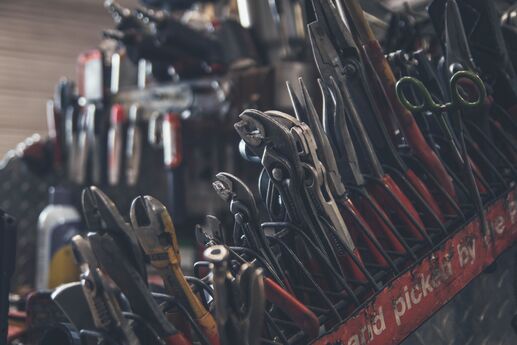
That infamously capricious black hole — the one that gleefully sucks a single sock from the dryer and relocates car keys to the top of the refrigerator — also has an appetite for tools. Few things are more frustrating than searching for that screwdriver that was lying in plain sight just yesterday.
The solution to this problem lies in organization and planning. Expert woodworkers devise tool storage systems that allow them to work efficiently … and possibly avoid uncouth fits of rage. Systems vary, but most integrate variations on similar themes.
A word of caution: There’s a fine line between organization and obsession. The best methods of tool storage blend common sense and simplicity.
It’s a Plan, Stan
Think about layout if building a shop from scratch. What tools do you use most frequently? Are they within easy reach of your workbench? Where should you put infrequently used tools? Sketch out a rough design, start pounding nails and refine as necessary.
Mix and Match
Successful woodworkers usually combine tool storage systems. Wall-mounted pegboards are unobtrusive and permit you to find tools with a glance. The same is true of hook and slat systems, which are especially handy for baskets and bins. Hook and slat systems may be converted into sliding panels several layers deep (think of sliding blackboards). Your mandatory gadgets are up front; lesser-used implements are to the rear.
A Long Shelf Life
You can never have enough friends, money or shelves. Horizontal shelves under your workbench hold lumber (keeping it flat to avoid warping) and medium-sized power tools. Shelves, whether freestanding or built-in, keep bottles of glue, solvents and finishing liquids safe and out of the way. As with pegboards, items on shelves are located visually. For some reason, the top shelf of every shop contains the ubiquitous clock radio.
High-Level Cabinet Meetings
Tool cabinets with slide-out drawers are common … and they’re commonly a mess. Keep specific items in specific drawers and label accordingly. Devote individual drawers to socket sets, chisels, sandpaper or that pack of smokes you’re hiding from your spouse. Place the most important items in the upper drawers.
An expert woodworker in North Carolina salvaged a set of kitchen cabinets and installed them on his shop walls. Behind one door are shelves filled with fastening devices and brackets, behind another are extensions cords and squares. Beyond door #3 lie nails, screws and bolts. All are packaged in plastic containers, conveniently labeled for easy identification.
Don’t Break Up the Band
Tools are like a high-school clique – they prefer each other’s company – and grouping tools is arguably the most important aspect of rational storage. Keep screwdriver sets and wrenches in specific spots, preferably in size order. The same goes for chisels, sockets, hammers and saws. Madness ensues if your screwdrivers and box-end wrenches are distributed hither, yon and under the workbench. Segregate common tools, and replace them in the appropriate spot after each use.
The same goes for drill bits. Spending an hour searching for a 1/4-inch spade bit is no fun. It’s a certainty, in a disorganized shop, that you’ll trip across every hole-saw bit you own before you find it.
Think Outside the Toolbox
Fixtures for tool storage are often fabricated from items around your home. A tie-rack holds a multitude of wrenches. Tin pie plates (cut in half and screwed to a wall) hold saw blades or sanding discs. Coffee cans make excellent hardware bins, as do electrical junction boxes.
A-frame-style racks are popular for clamps, but don’t forget that ceilings play a part in tool storage. My own shop features a heavy wire stretched wall-to-wall and secured by two eye-screws. It’s within easy reach and holds 40 clamps. I’m never in doubt a clamp is close at hand.
Sadly, the same cannot be said for my keys and socks.
